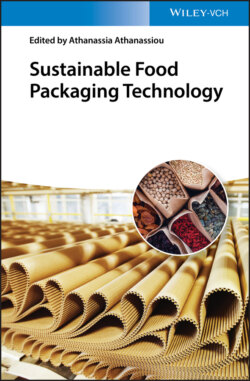Читать книгу Sustainable Food Packaging Technology - Группа авторов - Страница 38
2.2.3 Food Shelf Life Extension Using Fish Gelatin Films and Coatings
ОглавлениеFish gelatin films and coatings can be employed to improve food quality and extend food shelf life. In recent years, different strategies have been used for this purpose. Cross‐linking usually enhances film barrier properties, increasing water, light, and chemical resistance [84]. In this regard, Etxabide et al. [85] employed a commercial cod fish gelatin, using lactose as a cross‐linker, and Taghizadeh et al. [86] incorporated riboflavin into fish gelatin film forming solutions to carry out a photosensitizer‐induced cross‐linking. Both studies showed improved light barrier properties, which highlight the potential of these films to prevent food oxidation caused by light, contributing to extend food shelf life.
Active packaging, antioxidant and/or antimicrobial packaging, is a strategy to extend food shelf life. In the last few years, gelatin of diverse aquatic fish species has been employed on active films and coatings, in which different additives were used as antioxidant and antimicrobial agents. Some of these works are outlined in Table 2.1. Adilah et al. [88] incorporated mango peel extract into fish gelatin film forming solutions, obtaining a material with excellent free radical scavenging activity due to the high presence of polyphenols, carotenoids, phytochemicals, enzymes, vitamin C, and vitamin E on mango peels. It is worth mentioning that mango skins contribute about 7–24% from the whole fruit weight, and so, using this by‐product will help in reducing waste. Aloe vera was also used as an antioxidant agent with fish gelatin, obtaining films that exhibited antioxidant properties dependent on A. vera concentration [98]. Thereby, control and 9% A. vera films showed 65.78% and 74.76% 1,1-diphenyl-2-picrylhydrazyl (DPPH) radical as well as 32.59% and 65.24% 2,2′-azino-bis-3-ethylbenzthiazoline-6-sulphonic acid (ABTS) radical scavenging activity values, respectively. Similarly, epigallocatechin gallate, one of the major flavanols obtained from tea extract, was added into tilapia skin gelatin film forming solutions in order to prepare active films [91]. Apart from providing antioxidant activity, epigallocatechin gallate enhanced the UV light barrier properties of films, contributing significantly to the food shelf life extension. Liang et al. [94] employed a commonly used traditional Chinese medicine for the extraction of esculine, a natural antioxidant agent, which was then incorporated into sturgeon skin gelatin film forming solutions to prepare films intended to be used as food packaging materials for long‐term preservation. Moreover, films containing this antioxidant formed non‐covalent cross‐linkages between the hydroxyl group of esculine and amino acid residues of gelatin that enhanced chemical, physical, and mechanical properties.
Table 2.1 Fish gelatin‐based active films and coatings.
| Fish gelatin | Packaging | Bioactives | Bioactivity | References |
|---|---|---|---|---|
| Silver carp skin | C | Curcumin/β‐cyclodextrin | AO + AM | [87] |
| Tilapia fish skin | F | Mango peel extracts | AO | [88] |
| Rousselot 200FG | F | Tyrosol, ferulic and caffeic acids + chitosan | AO | [89] |
| Hagfish skin | F | Cinnamon‐bark essential oil | AO + AM | [90] |
| Tilapia skin | F | Epigallocatechin gallate | AO | [91] |
| Silver carp skin | F | Curcumin/β‐cyclodextrin | AO | [92] |
| Commercial tilapia (Oreochromis niloticus) | C | Tea polyphenol | AO + AM | [93] |
| Sturgeon skin | F | Esculine | AO | [94] |
| Atlantic salmon (Salmo salar) skin | F | Boldine | AO + AM | [95] |
| Rousselot 200FG | F | Coumarin + chitosan | AO | [96] |
| Commercial tilapia | C | Chitosan | AM | [97] |
C, coating; F, film; AO, antioxidant; AM, antimicrobial.
Some antioxidant additives show limitations, such as the poor solubility of curcumin, the major bioactive compound of curcuma rhizome (Curcuma zedoaria), which has been regarded as a spice, food preservative, and flavoring and coloring agent, approved for use in food industry. Wu et al. [92] and Sun et al. [87] encapsulated curcumin in β‐cyclodextrin to overcome this problem, and combined the complex with silver carp skin to prepare active films and coatings, respectively. Furthermore, it was observed that curcumin could inhibit microbial propagation. This combination of antioxidant and antimicrobial activities can be observed in several additives used with fish gelatin, for instance, in cinnamon‐bark essential oil [90] and in tea polyphenol [93]. On the other hand, some fish gelatin species have inherent antimicrobial or antioxidant activity, as in the case of Atlantic salmon [95] or cuttlefish [99], respectively.
Besides incorporation of cross‐linkers and antimicrobial and antioxidant agents into fish gelatin films and coatings, blending with other polymers such as polysaccharides could be another approach to extend food shelf life. For instance, fish gelatin and chitosan, a polymer that has intrinsic antimicrobial properties, have been shown to be compatible. When chitosan is positively charged and gelatin is negatively charged, under proper pH conditions, both biopolymers can be associated through electrostatic and hydrogen bonding. Thus, tilapia fish gelatin–‐chitosan coatings were analyzed and it was found that these coatings significantly prevented deterioration of golden pomfret fillet at 4 °C, inhibiting the degradation of myosin light chain and myoglobin [97], as well as coumarin [96]. Furthermore, the addition of natural antioxidants (ferulic acid, caffeic acid) showed that films containing caffeic acid or a caffeic–ferulic acid mixture exhibited a high radical scavenging activity [89].
